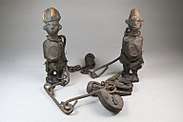Kongo religion
Kongo religion (KiKongo: Bukongo) is a broad set of traditional beliefs from the KiKongo speaking peoples. The faith bases itself in the idea of a main creator god named Nzambi Mpungu who made the world and spirits who inhabit it. Priestly doctors known as Nganga try to heal followers minds and bodies. Mediatory roles like being a Nganga require legitimization from the other world of spirits and ancestors.[1] The universe is split between two worlds, one of the living (nza yayi) and a world of the dead (nsi a bafwa), these worlds are split by a body of water. Humans continually pass through these worlds in cycle.[2]
| Part of a series on |
| Kongo religion |
|---|
 |
| Theology and concepts |
| Derivatives |
History
The traditional religion has its roots in Bantu speaking peoples in Africa. As the faith came to the Americas it retained various traditions but often mixed with other faiths. Some surviving traditions include possession by the dead to learn wisdom from the ancestors, and working with Nkisi. The religions that have preserved Kongo traditions include Palo Mayombe, Kumina, Haitian Vodou, Lumbalú and Candomblé.[3]
Beliefs
General cosmology
The religion of the Kongo is deeply complex. According to historian John K. Thornton "Central Africans have probably never agreed among themselves as to what their cosmology is in detail, a product of what I called the process of continuous revelation and precarious priesthood."[4] The Kongo people had diverse views, with traditional religious thought best developed in the northern Kikongo-speaking area.[4] There is plenty of description about Kongo religious ideas in the Christian missionary and colonial era records, but as Thornton states, "these are written with a hostile bias and their reliability is problematic".[5] Kongo beliefs included Kilundu as Nzambi (god) or Jinzambi (gods, deities), all had only limited powers.[6]
In general, according to the Kongo cosmogram, the creator god resides at the top of the world, the spirits living below and water existing in the middle where the two worlds meet.[7]
Spirits as well as dead ancestors could be communed with and those with authority got special rights to such communing. The priestly Nganga can interact with such spirits and ancestors. They would use spiritual cures to battle black magic in the world, sometimes using Nkisi. Nganga are not allowed to use black magic and only assisted clients to bring upon good fortune.[8]
Practices and charms
Humans may manipulate the universe through the use of charms called Nkisi. Within these charms are natural objects since it is believed all natural things contain a soul. These charms protect humans either by embodying a spirit or by directing a spirit to hunt evil.[7]
Spirits
After death a persons soul leaves the body to become a ghost and usually enters the land of the dead. Those who have done evil in life (such as witches) cannot enter the land of the dead and instead roam the Earth. A practitioner may commune with their family's ancestor spirits in a linear fashion, they may not commune with spirits who are not their ancestors.[7]
See also
References
- "Kongo Religion". encyclopedia.com. 2005.
- "Kongo Religion". philatar.ac.uk.
- "Kongo religion". meta-religion.com.
- John Thornton, "Religious and Ceremonial Life in the Kongo and Mbundu Areas," in Linda M. Heywood (ed) Central Africans and Cultural Transformations in the American Diaspora (London and New York: Cambridge University Press, 2002), ISBN 978-0-521-00278-3, pp. 73-74.
- John Thornton (2002), "Religious and Ceremonial Life," Cambridge University Press, ISBN 978-0-521-00278-3, pp. 72-73.
- John Thornton (2002), "Religious and Ceremonial Life," Cambridge University Press, ISBN 978-0-521-00278-3, pp. 74-77
- Gibson, Kean (2001). Comfa Religion and Creole Language in a Caribbean Community.
- Erwan Dianteill. Kongo in Cuba: the Transformations of an African Religion. Centre for the Interdisciplinary Study of Religious Phenomena. pp. 59–80.